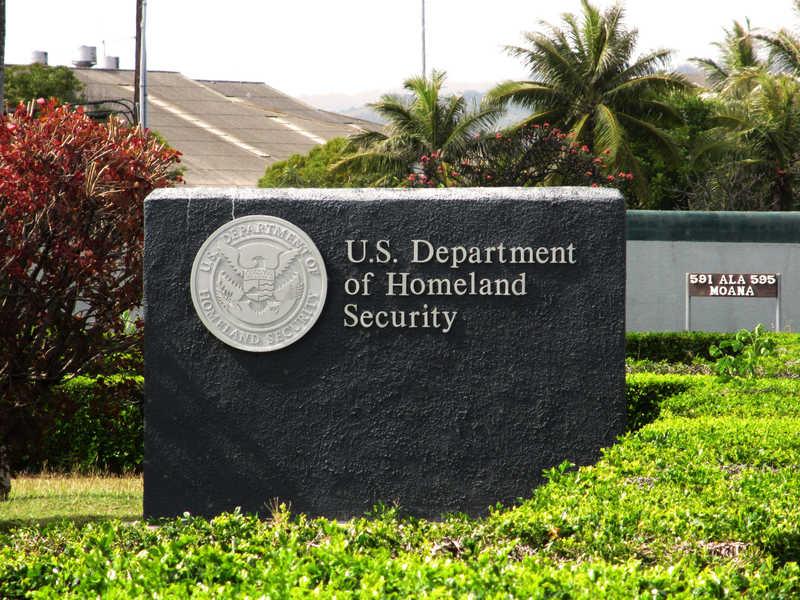DHS’s Unintelligible Threat Bulletin

US Department of Homeland Security - Sign on Oahu, Hawaii.
The Department of Homeland Security (DHS) announced January 27th that a heightened threat environment existed in the country due to what they described as:
“ideologically-motivated extremists with objections to the exercise of governmental authority and the presidential transition as well as other perceived grievances fueled by false narratives, could continue to mobilize to incite or commit violence.”
The bulletin goes on to say that “Domestic Violent Extremists (DVEs)” –a newly created term:
“targeted individuals with opposing views engaged in First Amendment-protected, non-violent protest activity. DVEs motivated by a range of issues, including anger over COVID-19 restrictions, the 2020 election results, and police use of force have plotted and on occasion carried out attacks against government facilities.”
It is unclear exactly to what this refers. The term Domestic Violent Extremist (DVE) was established as a joint term by the DHS and FBI following a requirement inserted into the National Defense Authorization Act which mandated a standardized definition.
Curiously, while the Bulletin claims the definition of DVE is provided within the DHS Lexicon, in fact it does not appear at the attached link. Instead, only the phrase “domestic terrorism” appears. A note on the FBI/DHS NDAA report notes that DHS’s Office of Intelligence and Analysis uses the phrase “domestic terrorist” interchangeably with the phrase “domestic violent extremist.”
It seems unlikely the new bulletin refers to the multiple months of Antifa-led attacks against police precincts, ICE facilities, and courthouses, including attacks as recent as this week. DHS briefly utilized the term “Violent Antifa Anarchist Inspired” (VAAI) to refer to individuals responsible for attacks on Portland’s Hatfield Federal Courthouse and other federal facilities. A 2016 report from Obama-era DHS described Antifa as the primary instigators of violence at public rallies.
The bulletin may refer to claims by the FBI that incidents similar to the violent January 6th U.S. Capitol riot were likely to occur at State capitols, alleging “a huge uprising” around the country on or around Inauguration day. Over 25,000 U.S. National Guard troops were dispatched to Washington D.C. as a result of alleged threats, in a move widely panned as a political theater. No incidents occurred.
The DHS bulletin also mentions potential:
“[T]hreats of violence against critical infrastructure, including the electric, telecommunications and healthcare sectors, increased in 2020 with violent extremists citing misinformation and conspiracy theories about COVID-19 for their actions.”
This is likely a reference to the Christmas Day Nashville bombing outside an AT&T building which resulted in massive downtime for regional telecommunications and 911 systems. Some media speculated that the alleged perpetrator Anthony Quinn Warner (who died in the bombing) was motivated by popular online conspiracy theories regarding 5G networks and COVID-19. Yet Tennessee Bureau of Investigations Director David Rauch said the motivation was undetermined noting, “We may never find out the exact reasoning behind the activity that took place.”
The Nashville bombing has therefore not been classified as domestic terrorism as no motivation has been formally assigned for the attack.
Yet the bulletin would appear to be advancing the claim that irrational beliefs and delusions –such as belief in lizard people, a view Warner allegedly held—can be classified as a political motivation. This is problematic for several reason, even as we acknowledge that the Nashville bombing revealed a serious vulnerability which may be exploited by future threats.
For one thing it places DHS in the position of adjudicating what constitutes a “false narrative,” and likely into extending its search for potential terrorists into the realm of constitutionally protected speech. It also runs the risk of attempting to frame otherwise legal speech or even mere internet rumor as somehow constituting criminal incitement or support for terrorism.
Lastly the DHS bulletin contains a reference to three Homegrown Violent Extremist attacks against government officials in 2020 but the actual incidents go unidentified. Homegrown Violent Extremist (HVE) is a DHS euphemism usually meant to refer to individuals inspired by Al Qaeda or the Islamic State but who were not formally members of a foreign terrorist group.
This most recent DHS bulletin continues to fall victim to a contrived and shifting lexicon, which creates confusion and doubt about apparent threats.
U.S. intelligence and law enforcement agencies should speak clearly and frankly about apparent threats in ways which most accurately communicate the nature of the ideological threat, its objectives, capabilities, and intent. Until it does so, such bulletins –presumably intended to be helpful and educate about potential threats—will be interpreted as vague, overarching, and increasingly politicized.
- How Trump’s Antifa Terrorism Sanctions Could Throttle Its Global Support Network - November 29, 2025
- Terrorist Designation for Muslim Brotherhood a Huge Blow: Kyle Shideler - November 25, 2025
- Antifa groups designated as FTOs - November 17, 2025
